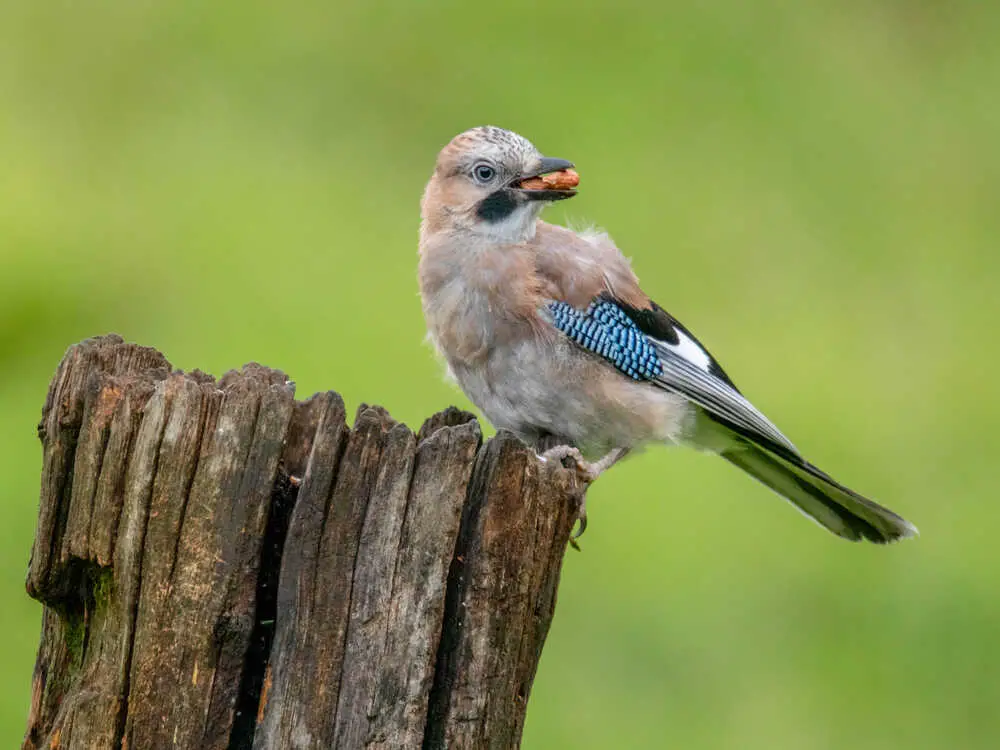Jays are secretive, shy birds that spend most of their time in deciduous and conifer woodlands. They do visit gardens but often at sunrise, so most of us miss them.
As the most colourful member of the crow family, with a pink body and flashes of black, white, and blue.
Instead of just hearing their shrill call, it would be nice to have regular visits from them. I decided to research how to attract jays to your garden and share my findings.

There are 2-main ways to every bird’s heart; a steady supply of food and somewhere safe to shelter.
Jays are tempted by both; they like sheltered, well-established gardens with lots of dense vegetation, and enough peanuts and mealworms to fill them until they’re fit to burst.
Table of Contents
Which foods tempt jays?
If you’re lucky enough to have a large garden with mature oak trees, then you must already have visiting jays. They adore acorns, both fallen ones and still on the tree.
They bury as many as 3000 acorns each season, to retrieve in late winter and spring.
In smaller gardens, there is a selection of prepared foods and scraps that jays eat.
Peanuts
Peanuts are jays favourite, they eat them whole, shelled, or crushed. Although they are larger than most songbirds, they are still agile enough to eat them from hanging feeders. I like to sprinkle some on the flat table surface to make things a little easier for them, they will also eat from a ground feeder.
Mealworms
In the wild, jays eat insects and bugs and often feed them to their young. Mealworms are a good substitute, although I prefer to buy the slightly more expensive live ones.
Dried mealworms are fine for an occasional snack, but if you take a close look at the cheaper packets, it is mostly empty husks. These have virtually no nutritional value to any bird.
Sunflower seeds
Jays have strong beaks that make light work of shelling sunflowers to get to the juicy hearts inside. If you prefer less mess provide sunflower hearts, and you should attract lots of birds, not just jays.
Suet
Suet is high in calories and fat so a fantastic food for birds during winter. They store the fat to give them enough heat and energy to make it through the night.
Mixed seed
Jays will eat mixed birdseed; lookout for a mixture specially designed for jays and other birds.
Fruit
Jays are partial to grapes and cherries, and peck at fruits such as elderberry, strawberry, and blackberry.
Jays are resourceful birds that eat a wide range of food, especially if they have young to feed.

Think about where you place the feeding table
Jays don’t like to be out in the open for long, so won’t visit a table out in the open.
They prefer feeding stations with lots of nearby cover, they can dash to if disturbed.
As predators themselves, they are aware of nearby dangers, maybe more than other songbirds. Even if a feeder is laden with peanuts, if there is a possibility that danger is lurking in a close-by tree or bush, the jay will carry on its way to find food elsewhere.
Don’t forget water
Jays need a constant supply of water, not only to drink but to bathe in. It is even more important in winter when other resources are frozen. Jays need to keep their feathers clean and in top condition.
Providing shelter for jays
Although jays prefer deciduous woodland to build their nest, they are tempted into mature gardens with dense shrubbery. They look out for lots of trees, preferably broadleaf ones, firstly because they are usually rife with insects, and secondly, to provide the shelter that they crave.
Thick climbing plants and dense vegetation pique jays interest. They are solitary creatures that are always on the lookout for food and somewhere to hide.
Do jays use bird boxes?
It is unlikely that a jay will use a bird box to nest in as they are not cavity nesters.
Birds that nest in naturally occurring crevices and holes in trees and buildings use boxes.
The only type that could attract a jay is an open-fronted one, similar to an owl box. Even then, jays prefer to build their own scruffy nest, in the bough of a tree.
Final thoughts
There is one guaranteed way to attract jays to your garden; plant a forest full of oak trees!
If you haven’t got the space, or 20+ years to wait around while they mature, sprinkle your tables with peanuts and mealworms and keep your fingers crossed.
